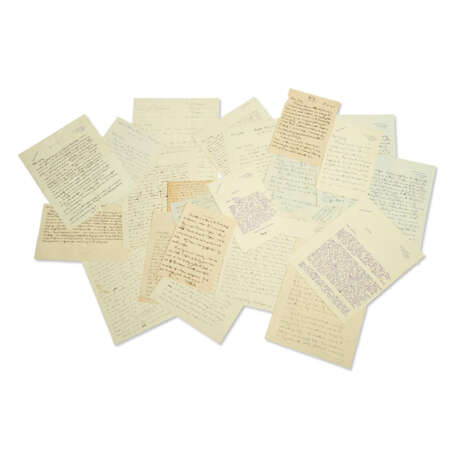ID 1108896
Lot 97 | Edward Morgan Forster (1879–1970)
Valeur estimée
£ 10 000 – 15 000
Series of 18 autograph letters, two typed letters and one autograph postcard signed ('Morgan', 'E.M.F.', 'E.M. Forster') to Sydney Waterlow, 5 January 1921 - 30 August 1944 and n.d.
Approximately 35 pages, various sizes; with autograph notes of a meeting with Henry James, 24 January 1908 ('Tea with Henry James – less exciting than I expected'), one page. Provenance: Sotheby's, 14 December 1992, lots 148 and 149.
'The characters in a novel that's creative art go on living after the novel's done and would have lived if it had never been written'. The earliest letter in the series responds to a 'metaphor' of Waterlow's that expresses Forster's own feelings about the independent existence of characters in a true novel. In the following month, Forster asks for Waterlow's help in smoothing his own passage to India (for his second visit), announcing announcing his appointment as personal secretary to the Maharaja of Dewas, Senior Branch: ''I am trying to go to India at once ... So good a chance of getting East can't be neglected ... I know not how all will end, but life is too alarming to inspect more than its nearest scraps'; he plans to stop at Port Said on the way out, and in Egypt on the way back, but notes 'my real reasons are private. I want to see friends, and I have an Affair there'. Whilst struggling with the writing of A Passage to India he reflects 'I must try to think what I think about this "mystic stuff" ... I have no use for it and never shall have. I am after it in my novel ... I wish I could get it done' (10 September 1923). On the publication of the novel, he responds to Waterlow's appreciation of it: 'I had to include Anglo India and to treat it as justly as I could, otherwise I couldn't have completed the book ... Over Adela I don't agree; no thumping success, to be sure, but sympathy as well as fairness of mind went to her make up, and I quite often hear her voice ... how glad I am you like ch. XXIII, also Godbole generally and Aziz. In various ways I am very fond of them'.
The letters include a number of references to other writers, including Katherine Mansfield's view of Virginia Woolf, 'K.M. in one of my rare conversations with her complained that Virginia's art had no penumbra, wasn't, her metaphor ran, a broken off piece of living stuff, and implied that her own was, or that if one implied it wasn't the evening would be a failure socially' (5 January 1921), to an odd comment from Woolf herself, 'Virginia writes that I "seem to be very careless with my pants". Do you know what she means?' (6 September 1922), and to a meeting with Thomas Hardy, evoking 'the extreme oddness of my visits to the Hardys. Am I constitutionally incapable of evoking greatness? Not one sign of it can I discern' (20 July 1922). His notes of his meeting with Henry James in 1908 are equally underwhelming; letters in 1943 and 1944 refer to T.S. Eliot and Ezra Pound. On a rarer but characteristically evasive personal note, Forster writes a memory of his youth, and a reflection on his sexual identity: 'I would have learnt dancing myself could I have found any protuberance on the little girls of which I could have caught hold. My hand slipped off, and that is why I live alone at the present minute' (22 September 26).
Sir Sydney Waterlow (1878-1944) was a contemporary of Forster's from Cambridge, and was the nephew of Elizabeth von Arnim, whose daughters Forster tutored in 1905. He proposed unsuccessfully to Virginia Woolf in 1911.
| Artiste: | Edward Morgan Forster (1879 - 1970) |
|---|---|
| Lieu d'origine: | Angleterre, Royaume-Uni |
| Artiste: | Edward Morgan Forster (1879 - 1970) |
|---|---|
| Lieu d'origine: | Angleterre, Royaume-Uni |
| Adresse de l'enchère |
CHRISTIE'S 8 King Street, St. James's SW1Y 6QT London Royaume-Uni | |||||
|---|---|---|---|---|---|---|
| Aperçu |
| |||||
| Téléphone | +44 (0)20 7839 9060 | |||||
| Commission | see on Website | |||||
| Conditions d'utilisation | Conditions d'utilisation |






